Buenos Aires – The current issue of El Gourmet, the magazine of the Argentina based South American food channel, opines that Peruvian food is the new hot commodity in Buenos Aires. This is, of course, music to Henry’s ears. The magazine’s evidence for this is the relatively recent opening of a whopping count of two restaurants that offer cuisine “inspired” by that of Peru. One of the two was opened by a chef from Trujillo, his hometown, so off we went yesterday for lunch to Zadvarie DOC, Uriarte 1423, in Palermo Viejo. (I’m guessing the DOC comes from the common usage in the wine world of Denominacion de Origin Calificada to designate wine regions of quality.) Their business card describes the food as cocina de inspiración peruana (Peruvian inspired cuisine), and sabores del altiplano (flavors of the high plains). [This place closed over a lease dispute in early 2009.]
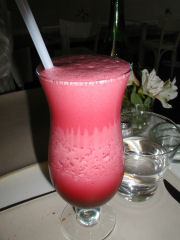 The place is very sleek and modern looking, all done up in various hues within the white to beige range. There’s an open kitchen, a small patio, and a rooftop terrace for dining. The restaurant also offers a well stocked bar and a decent wine list. We were immediately presented with menus and a basket of traditional Peruvian breads, plus offered water and/or drinks without the usual wait for our full order. Major brownie points. We ordered a round of chicha morada, a traditional Peruvian soft drink made from purple corn. Instead of the usual extract, water and ice, Zadvarie very smartly turns this into a blended drink quite similar to a liquado.
The place is very sleek and modern looking, all done up in various hues within the white to beige range. There’s an open kitchen, a small patio, and a rooftop terrace for dining. The restaurant also offers a well stocked bar and a decent wine list. We were immediately presented with menus and a basket of traditional Peruvian breads, plus offered water and/or drinks without the usual wait for our full order. Major brownie points. We ordered a round of chicha morada, a traditional Peruvian soft drink made from purple corn. Instead of the usual extract, water and ice, Zadvarie very smartly turns this into a blended drink quite similar to a liquado.
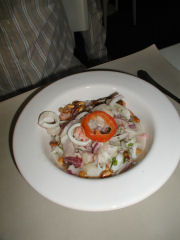 The menu is a little confusing in its layout, with no real guide to which dishes are considered appetizers and which are entrees other than price. There are random placements of what seem to be able to ordered as either side dishes or appetizers as well. Many dishes have two prices after them, on asking, sometimes it’s a difference between appetizer and entree, sometimes it’s a difference in whether you select the dish a la carte or as part of a set menu (which have set prices, so I wasn’t clear why there was a need to do this…). Henry decided to order a ceviche mixto, his litmus test for whether a Peruvian restaurant is worth visiting again. It was pretty spectacular, with a mix of fish and shellfish, perfectly seasoned, just a little spicy with the use of rocoto peppers, not easy to find here.
The menu is a little confusing in its layout, with no real guide to which dishes are considered appetizers and which are entrees other than price. There are random placements of what seem to be able to ordered as either side dishes or appetizers as well. Many dishes have two prices after them, on asking, sometimes it’s a difference between appetizer and entree, sometimes it’s a difference in whether you select the dish a la carte or as part of a set menu (which have set prices, so I wasn’t clear why there was a need to do this…). Henry decided to order a ceviche mixto, his litmus test for whether a Peruvian restaurant is worth visiting again. It was pretty spectacular, with a mix of fish and shellfish, perfectly seasoned, just a little spicy with the use of rocoto peppers, not easy to find here.
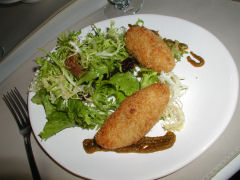 I started off with the yuca rellena con camarones, deep-fried and stuffed fingers of mashed yuca root filled with a simple mix of shrimp and corn. Somewhat bland in themselves, they were elevated to excellent by the use of a salsa llajwa, something we weren’t familiar with. The manager explained that it is a traditional sauce from the Andes, especially Bolivia, that is made of dried tomatoes, rocoto peppers, and two herbs – huacatay from Peru and quirquiña from Bolivia. The former is found in other parts of the world and is also known as the John Henry herb; the latter is an aromatic herb reminiscent of coriander. The sauce, with a quick internet search, appears to be a very common condiment in the Andes and is also known as Bolivian Hot Sauce.
I started off with the yuca rellena con camarones, deep-fried and stuffed fingers of mashed yuca root filled with a simple mix of shrimp and corn. Somewhat bland in themselves, they were elevated to excellent by the use of a salsa llajwa, something we weren’t familiar with. The manager explained that it is a traditional sauce from the Andes, especially Bolivia, that is made of dried tomatoes, rocoto peppers, and two herbs – huacatay from Peru and quirquiña from Bolivia. The former is found in other parts of the world and is also known as the John Henry herb; the latter is an aromatic herb reminiscent of coriander. The sauce, with a quick internet search, appears to be a very common condiment in the Andes and is also known as Bolivian Hot Sauce.
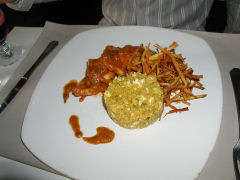 While the main courses listed several pretty classic Argentine selections, clearly a bow towards local custom, the more interesting selection were the Peruvian inspired selections. Henry dug into a pepian del pollo, a very classic dish. A pepian is a sauce that is thickened with ground nuts and seeds, in this case peanuts and chickpeas. The presentation was appropriately fancied-up, the main courses are presented on inordinately large square plates, making the food look a bit skimpy when it’s actually more than enough. The sauce was, once again, dead-on. The dish was served with a squat cylinder (a form that I saw used on pretty much every main course plate that came out of the kitchen) of quinoa lightly sauteed with eggs and herbs and a mound of papas pays, or shoestring potatoes.
While the main courses listed several pretty classic Argentine selections, clearly a bow towards local custom, the more interesting selection were the Peruvian inspired selections. Henry dug into a pepian del pollo, a very classic dish. A pepian is a sauce that is thickened with ground nuts and seeds, in this case peanuts and chickpeas. The presentation was appropriately fancied-up, the main courses are presented on inordinately large square plates, making the food look a bit skimpy when it’s actually more than enough. The sauce was, once again, dead-on. The dish was served with a squat cylinder (a form that I saw used on pretty much every main course plate that came out of the kitchen) of quinoa lightly sauteed with eggs and herbs and a mound of papas pays, or shoestring potatoes.
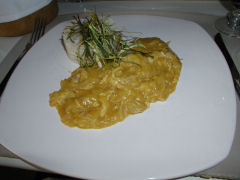 I chose an ají de gallina, one of my personal favorites. Although ají typically means chili pepper, in terms of dishes it is a term for a sauce made from oil, vinegar, garlic and chilies. In this case, thin strips (hebras) of hen were stewed in the sauce, which was thickened, probably with a little manioc starch. The sauce was appropriately spicy and quite garlicky, which I really liked. The accompaniment was a simple cylinder of rice. An interesting garnish of crunchy, deep-fried, threads of green onion was strewn about the plate, it made a nice contrast in texture, and added a little depth to the flavor.
I chose an ají de gallina, one of my personal favorites. Although ají typically means chili pepper, in terms of dishes it is a term for a sauce made from oil, vinegar, garlic and chilies. In this case, thin strips (hebras) of hen were stewed in the sauce, which was thickened, probably with a little manioc starch. The sauce was appropriately spicy and quite garlicky, which I really liked. The accompaniment was a simple cylinder of rice. An interesting garnish of crunchy, deep-fried, threads of green onion was strewn about the plate, it made a nice contrast in texture, and added a little depth to the flavor.
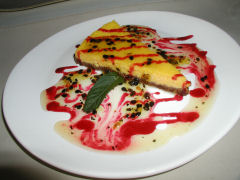 At this point, despite being quite full, we couldn’t resist sampling one dessert. Though obviously not at all classically Peruvian (in fact, none of the four dessert offerings were Peruvian, or for that matter, particularly “Latin American” in style), we ordered a cheesecake de maracuyá, or passion-fruit cheesecake. I have to admit to a preference for a deep dish style baked cheesecake – very classic Eastern European. This was far closer to the New York style which I’m not overly fond of. Still, it was pretty good, and a puree of passion-fruit had been mixed right into it, giving it a fairly intense yellow color. The crust was chocolate, a nice touch, and a trio of passion-fruit, raspberry, and mint sauces graced the plate, along with a garnish of passion-fruit seeds.
At this point, despite being quite full, we couldn’t resist sampling one dessert. Though obviously not at all classically Peruvian (in fact, none of the four dessert offerings were Peruvian, or for that matter, particularly “Latin American” in style), we ordered a cheesecake de maracuyá, or passion-fruit cheesecake. I have to admit to a preference for a deep dish style baked cheesecake – very classic Eastern European. This was far closer to the New York style which I’m not overly fond of. Still, it was pretty good, and a puree of passion-fruit had been mixed right into it, giving it a fairly intense yellow color. The crust was chocolate, a nice touch, and a trio of passion-fruit, raspberry, and mint sauces graced the plate, along with a garnish of passion-fruit seeds.
Overall, high points for food, service, and ambiance. Truthfully, also worth the price of just under 100 pesos ($32 right now) for lunch, though that obviously makes it a place where I’m not likely to pop by daily for a bite.
Hi, Dan. What is your (or Henry’s) opinion of the Peruvian restaurant in Congreso, on Virrey Ceballos?
We’ve eaten at Status several times, it’s quite good, and probably more authentic than this place, but overall quality-wise, this place tops it.
https://www.saltshaker.net/20050703/popcorn
https://www.saltshaker.net/20050807/mas-status
We’ve also eaten at Contigo Peru which I reviewed in the same review as the first one above.
[…] One of my favorite dishes is Ají de Gallina – shreds of chicken stewed in a peanut based sauce and served on top of potatoes. This version was particularly good, in fact other than the upscale version presented at Zadvarie DOC, the best I’ve had. […]
[…] Buenos Aires – Salsa Llajwa is sometimes known as the Bolivian National Hot Sauce. I first encountered it at a restaurant in Palermo, and it was so delicious that I’d asked the manager of the restaurant what was in it. He described it as containing the Peruvian herb huacatay and the Bolivian herb quirquiña, blended with rocoto peppers and oven dried tomatoes. I’ve spent a bit of time looking for recipes, figuring one of these days, like yesterday (see last post), I’d make it out to Liniers and possibly be able to find the key ingredients. Although he didn’t mention it, every recipe I saw included either onion or garlic, so I added in a shallot. Recipes varied wildly, using various herbs, generally on the aromatic side, but from coriander to mint to parsley, and the peppers varied as well – from just rocoto to rocoto and much hotter pepper combos, to others. […]
[…] Henry and I spent the day out introducing Bill to some of the sights of Buenos Aires – we launched into things locally with a tour of the Cementerio de Recoleta, with the appropriate visits to the mausolea of Evita and of Domingo Sarmiento, plus a bit of a wander. Henry’s never comfortable in the cemetery, so we didn’t stay long. From there we continued on to the Centro Cultural de Recoleta, which, unfortunately, has begun a massive renovation project, and virtually all the galleries were closed to the public. That left us meandering the walkways through the artisans’ stalls in the Fería de Recoleta, and by then, of course, hungry. Henry, as per usual, loves to show off Peruvian food, and wanted to return to Zadvarie, where we’d had a delightful lunch a few months ago. We did once again, this time seated on the rooftop terrace enjoying the beautiful weather. […]
[…] A few weeks ago one of our local food writers reviewed a new Japanese restaurant located just off the main strip in Barrio Chino. One of the assertions made was “Para empezar debo decir que probé las gyosas mejores de mi vida, sin exagerar.”, or, “To start I have to say the I tried the best gyozas in my life, without exaggeration.” At a later juncture, she also asserts that some of the sushi tried is, in essence, invented on site and not available anywhere else (an example given is salmon with mango and avocado, available from almost any sushi bar here I can think of). On the other hand, this same columnist recently wrote up one of our favorite Peruvian restaurants, Zadvarie, claiming that it is the only place in town offering ocopa arequipeña because they have the only source of huacatay herb in town through a store in Barrio Chino. We eat the dish regularly at other restaurants (and it’s better at some and not as good at others), and as regular readers here know, I buy huacatay in the markets in Liniers by the bagful for mere pesos. […]
[…] – this is the “individual” sized portion… Okay, perhaps the ceviches at Moche or Zadvarie have a touch more elegance, but they’re more expensive and a quarter the size – this was 27 […]
[…] you’re looking for interesting higher quality Peruvian food, both Moche and Zadvarie provide far better dining experiences; and if Peruvian-Japanese fusion is your desire, Osaka, while […]
[…] Moche is pricey – with wine and three courses, it ran us 150 pesos for two. About the same as Zadvarie, which is the other high end Peruvian spot in town. But despite how good that place is, Moche is […]